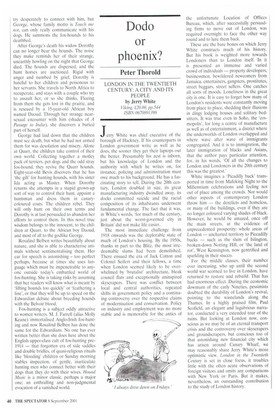Dodo or phoenix?
Peter Thorold
LONDON IN THE TWENTIETH CENTURY: A CITY AND ITS PEOPLE by Jerry White Viking £20.00, pp.544 ISBN 0670891398 Jerry White was chief executive of the borough of Hackney. If his counterparts in London government write as well as he does, the sooner they get their laptops out the better. Presumably his zest is inborn, but his knowledge of London and the authority with which he writes on, for instance, policing and administration must owe much to his background. He has a fascinating story to tell. During the 20th century, London doubled in size, its great manufacturing industry dwindled away, its docks committed suicide and the racial composition of its inhabitants underwent fundamental change. The fact that it was, in White's words, `for much of the century, just about the worst-governed city in Britain' did not make life easier.
The most immediate challenge from 1918 onwards was the deplorable state of much of London's housing. By the 1950s, thanks in part to the Blitz, the most irredeemable slums had been demolished. There ensued the era of Jack Cotton and Colonel Seifert and their fellows, a time when London seemed likely to be overwhelmed by 'brutalise architecture, bleak council flats and exceptionally uninspired skyscrapers. There was conflict between local and central authorities, repeated shifts in government policy and a continuing controversy over the respective claims of modernisation and conservation. Policy on industry and employment was no more stable and is memorable for the antics of the unfortunate Location of Offices Bureau, which, after successfully persuading firms to move out of London, was required overnight to face the other way round and to lure them back.
These are the bare bones on which Jerry White constructs much of his history. But his book is weighted more towards Londoners than to London itself. In it is presented an immense and varied crowd of individuals — property developers, businessmen, bewildered newcomers from Jamaica, entertainers, gangsters, prostitutes, street beggars, street sellers. One catches all sorts of moods. Loneliness in the great city is one. It is easy to forget how many of London's residents were constantly moving from place to place, shedding their illusions in dingy lodging houses and solitary bedsitters. It was true even in Soho, the 'cosmopolis', for long a centre of manufacture as well as of entertainment, a district where the underworlds of London overlapped and where wave after wave of immigrants congregated. And it is to immigration, the later immigration of blacks and Asians, that the author pays particular attention, for, in his words, `Of all the changes to London and Londoners in the 20th century this was the greatest.'
White imagines a Picadilly buck' transported in time from Mafeking Night to the Millennium celebrations and feeling not out of place among the crowds. Nor would other aspects of contemporary London throw him — the derelicts and homeless, or many of the buildings, even if they are no longer coloured varying shades of black. However, he would be amazed, once off the main streets, at the evidence of unprecedented prosperity: whole areas of London — uncharted territory to Piccadilly bucks — such as the slum of Islington, broken-down Notting Hill, or 'the land of rot', West Kensington, now gentrified and sparkling in their stucco.
For the middle classes, their number ever increasing, who up until the second world war scorned to live in London, have returned to restore and rebuild. That has had enormous effect. During the economic downturn of the early Nineties, pessimists doubted the durability of London's revival, pointing to the wastelands along the Thames. In a highly praised film, Paul Scofield, an elegant and lugubrious narrator, conducted a very extended tour of the ruins. But looking at London now, conscious as we may be of an eternal transport crisis and the controversy over skyscrapers and groundscrapers, but conscious too of that astonishing new financial city which has arisen around Canary Wharf, we may reasonably share Jerry White's more optimistic view. London in the Twentieth Century is set in close focus, it troubles little with the often acute observations of foreign visitors and omits any comparisons with New York or Paris. But it makes, nevertheless, an outstanding contribution to the study of London history.


































































 Previous page
Previous page